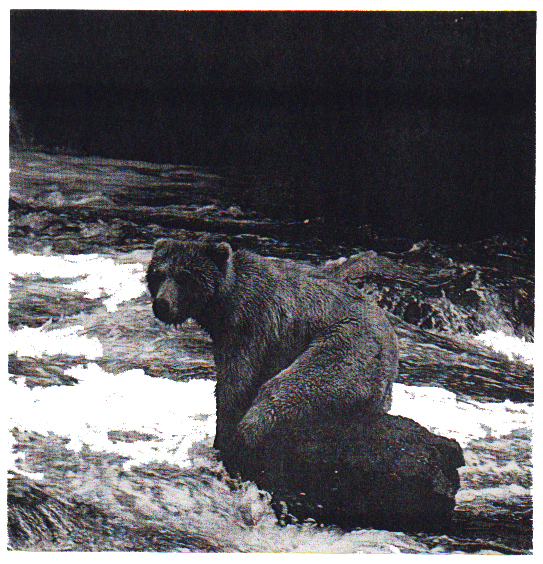 Marshall
Cultural Atlas Marshall
Cultural Atlas
This collection of student work is from
Frank Keim's classes. He has wanted to share these works for others
to use as an example of Culturally-based curriculum and documentation. These
documents have been OCR-scanned. These are available
for educational use only.

Grizzly Bear
The Grizzly Bear
The Grizzly bear is stout and rather chunky in shape, with
a large
hump of fat and muscle over the shoulders. It has very long claws.
People describe it as being somewhat "dish-faced" in appearance.
Grizzlies eat a lot of salmon, and when salmon are especially
numerous, they might eat just their favorite portions of the fish.
These bears often catch and eat up to twenty salmon in an hour.
Because of this, a bear could gain up to 6 pounds of fat in a 24 hour
period. Although their diet is mostly plant material, they eagerly
seek out animal matter because its food value is much more
concentrated.
Grizzly bears spend the winter hibernating in their dens.
Depending on the size of the bear, a sleeping chamber can measure
over 7 feet wide and 3 feet high. Some dens have been used for
centuries by numerous generations of bears. Grizzlies begin to
hibernate in the middle of September.
Grizzlies may live longer than thirty years and can reproduce
for
most of their lives. One female kept at the Leipzig Zoo was still
having cubs when she was twenty-six years old. Females generally
don't breed until they are at least five years old. The breeding
occurs in June or July. The bears give birth about 222 to 229 days
after copulation. The actual fetal growth takes only about sixty
days. A newborn Grizzly bear may weigh less than one pound, but
nursing cubs gain weight quickly because bear milk contains as much
as 33 percent fat . The cubs may increase their weight as much as
1,000 times. The sow bear will fiercely defend them from potential
harm. Their deaths are frequently due to encounters with adult males,
called boars. Wolves also sometimes prey on young Grizzly bear cubs.
The term "Grizzly" is a colloquial name that refers to the animal's
coloration. It means "grey-like." Most adult Grizzlies range from 350
to 700 pounds, rarely going over 1000 pounds. The Grizzly's
reputation for ferociousness toward people makes the animal seem much
larger.
Ninety percent of North America's estimated 40,000 bears are found
in Alaska, the Yukon ,the Rocky Mountains of Alberta and British
Columbia, and in the mainland Northwest Territories. Less than 800
bears still exist in the continental United States.
Grizzlies have suffered from both destruction of wildlands and the
belief that they are dangerous to cattle, sheep and humans. There
are, however, some attempts to protect them in their remaining
habitats.
Billy Waska

Bear Fire
Stories and Poems
about Bears
|
by Marshall High School
Language Arts Classes
Spring, 1992
Produced
by
Information
about Bears
Creative
Stories from the Imagination
True
Stories from Experience
Poems
Christmastime Tales
Stories real and imaginary about Christmas, Slavik, and the New Year
Winter, 1996 |
Christmastime Tales II
Stories about Christmas, Slavik, and the New Year
Winter, 1998 |
Christmastime Tales III
Stories about Christmas, Slavik, and the New Year
Winter, 2000 |
| Summer Time Tails 1992 |
Summertime Tails II 1993 |
Summertime Tails III |
| Summertime Tails IV Fall, 1995 |
Summertime Tails V Fall, 1996 |
Summertime Tails VI Fall, 1997 |
| Summertime Tails VII Fall, 1999 |
Signs of the Times November 1996 |
Creative Stories From Creative Imaginations |
| Mustang Mind Manglers - Stories of the Far Out,
the Frightening and the Fantastic 1993 |
Yupik Gourmet - A Book of
Recipes |
|
| M&M Monthly |
|
|
| Happy Moose Hunting! September Edition 1997 |
Happy Easter! March/April 1998 |
Merry Christmas December Edition 1997 |
| Happy Valentine’s
Day! February Edition
1998 |
Happy Easter! March/April Edition 2000 |
Happy Thanksgiving Nov. Edition, 1997 |
| Happy Halloween October 1997 Edition |
Edible and Useful Plants of Scammon
Bay |
Edible Plants of Hooper Bay 1981 |
| The Flowers of Scammon Bay Alaska |
Poems of Hooper Bay |
Scammon Bay (Upward Bound Students) |
| Family Trees and the Buzzy Lord |
It takes a Village - A guide for parents May 1997 |
People in Our Community |
| Buildings and Personalities of
Marshall |
Marshall Village PROFILE |
Qigeckalleq Pellullermeng ‘A
Glimpse of the Past’ |
| Raven’s
Stories Spring 1995 |
Bird Stories from Scammon Bay |
The Sea Around Us |
| Ellamyua - The Great Weather - Stories about the
Weather Spring 1996 |
Moose Fire - Stories and Poems about Moose November,
1998 |
Bears Bees and Bald Eagles Winter 1992-1993 |
| Fish Fire and Water - Stories about fish, global warming
and the future November, 1997 |
Wolf Fire - Stories and Poems about Wolves |
Bear Fire - Stories and Poems about Bears Spring,
1992 |
|